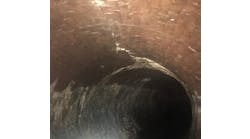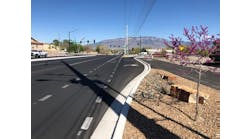Located in areas that experience occasional flooding, both projects involve
the installation of storm-water drainage systems to help alleviate the problem.
These projects also involve sizable investments-around $50 million on Ip;405
and almost $26 million on Route 18-a cost that could be even higher if the
contractors were not using high- density polyethylene (HDPE) pipe.
"In my opinion, polyethylene pipe is a good product because it can
be installed a lot easier and faster, and it requires less equipment, which
keeps the cost of installing the pipe down," said Bob Jones, the WSDOT
drainage inspector working on the Ip;405 upgrade.
Affecting 11 miles of roadway on Seattle's second most heavily traveled
highway, the stretch of Ip;405 being improved runs north-south between
Ip;90 and Ip;5. But what started out as a surveillance control and
driver information project has evolved to include noise abatement, retaining
walls, bridge widening and storm-water drainage and retention.
Most of the pipe going in along Ip;405 is Hancor Sure-Lok 10.8, which
meets WSDOT's stringent requirements for a testable, watertight joint. The
joining system features a unique integral-bell design with self-locking
cleats, which eliminates loose parts such as couplers and wire ties. The
10.8 pipe is designed to assure secure, reliable joint alignment and provide
watertight performance according to ASTM D 3212 standards.
In total, nearly 28,000 lin ft of 12-in., 18-in. and 24-in. Sure-Lok and
another 5,600 of 6-in. solid and perforated underdrainage pipe have been
ordered for the project.
"We're running the corrugated polyethylene pipe parallel to the center
line under the roadway, down the middle of 405," explained Barry O'Young,
project engineer with Tri-State Construction, the installation contractor.
"Because of the traffic volume, closing the roadway is not an alternative.
And when we're trenching in the roadway we're cramped for space. Polyethylene
pipe's light weight and 20 ft lengths increase the lineal footage we can
lay in a day, so we can get out of the way faster. Laying truckloads of
concrete pipe would cause logistical problems."
Currently in the state of Washington, corrugated polyethylene pipe is approved
in diameters up to 24 in. and burial up to 15 ft deep. For a series of 96-in.
and 120-in. retention pipes on the Ip;405 project, contractors specified
aluminized steel corrugated metal pipe.
"The drainage phase of this project is designed to make it work better
overall; to provide better retention and better water quality," Jones
said. In total, the 11-mile stretch of roadway includes four bridges, 10
retaining tanks, two main ponds and one auxiliary runoff pond.
On Route 18-where the state is building a new modified diamond-configuration
interchange and widening a two-lane road into a limited-access four-lane
highway-there are seven bridges, six ponds and a couple of sensitive slopes.
"The county has jurisdiction over sensitive areas such as streams,
stream buffers, wetlands and steep slopes," said Ron Paananen, WSDOT
project engineer. "On the steep slopes, the polyethylene pipe will
be installed right on the ground surface, rather than disturbing the slope
to bury it."
The majority of the pipe ordered for the Route 18 project-over 12,000 lin
ft-is corrugated polyethylene pipe in 12-in. and 18-in. diameters. Other
materials used in the storm-water-drainage system include 700 ft of concrete
pipe, 400 ft of PVC pipe and 54 ft of 60-in. structural steel plating that's
being used to reroute water runoff for dewatering and erosion control.
"Given the option, my first choice is always polyethylene pipe,"
said Dave Marshbank, president of Marshbank Construction, the drainage and
utilities subcontractor for the Route 18 project. "For one thing, HDPE
pipe is cost effective and it does the same job. It can also be stockpiled
in one area, so we just bring over bundles of pipe as we need them. That's
kind of the same situation with metal pipe, except that metal takes a while
to bolt together. With polyethylene, the pipe slips together easily and
it's testable."
Wide elevation changes along both highways contribute to heavy runoff and
flooding in adjacent low-lying areas, so the new storm-water drainage installations
are engineered to provide relief. "The 44th Street interchange on I-405
has basically always been a wetland, and the commercial property in that
area has always had water trouble," said WSDOT's Jones.
We're using the corrugated polyethylene pipe to feed into 42 in. by 29 in.
metal pipe arches and into the 72-in., 96-in. and 120-in. metal pipes, which
will give us better retention of sediments in the outflow systems,"
Jones said. "The drainage outflow system also contains coalescing plates,
which will allow better water cleansing."
Scheduled for completion in 1997-Ip;405 by late summer and Route 18 by the end of the year-both projects are sure to be seen as long-term headaches by motorists. However, according to Tri-State Construction's O'Young, the construction is certain to go a lot faster than it might otherwise. "I'm guessing it would take us at least 10% longer to do the project with concrete," he said. "With corrugated polyethylene pipe, the price is competitive, the performance is comparable and the construction time is a lot faster, so I know using it increases production and lowers costs."


